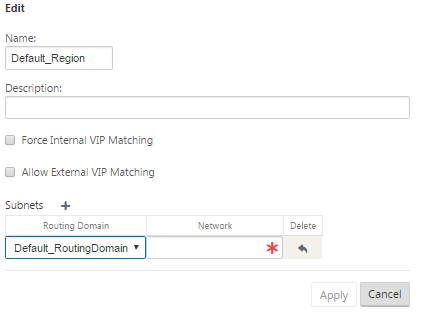-
-
Enable Edge Mode High Availability Using Fiber Optic Y-Cable
-
Single-region deployment
-
Configuration guide for Citrix Virtual Apps and Desktops™ workloads
-
Citrix SD-WAN Orchestrator™ on-premises configuration on Citrix SD-WAN appliance
-
-
This content has been machine translated dynamically.
Dieser Inhalt ist eine maschinelle Übersetzung, die dynamisch erstellt wurde. (Haftungsausschluss)
Cet article a été traduit automatiquement de manière dynamique. (Clause de non responsabilité)
Este artículo lo ha traducido una máquina de forma dinámica. (Aviso legal)
此内容已经过机器动态翻译。 放弃
このコンテンツは動的に機械翻訳されています。免責事項
이 콘텐츠는 동적으로 기계 번역되었습니다. 책임 부인
Este texto foi traduzido automaticamente. (Aviso legal)
Questo contenuto è stato tradotto dinamicamente con traduzione automatica.(Esclusione di responsabilità))
This article has been machine translated.
Dieser Artikel wurde maschinell übersetzt. (Haftungsausschluss)
Ce article a été traduit automatiquement. (Clause de non responsabilité)
Este artículo ha sido traducido automáticamente. (Aviso legal)
この記事は機械翻訳されています.免責事項
이 기사는 기계 번역되었습니다.책임 부인
Este artigo foi traduzido automaticamente.(Aviso legal)
这篇文章已经过机器翻译.放弃
Questo articolo è stato tradotto automaticamente.(Esclusione di responsabilità))
Translation failed!
Single-region deployment
Regions allow you to define a network hierarchy with distributed management. A Region must define a Regional Control Node (RCN) which will take over functions performed by the Network Control Node (MCN) for its Region. The MCN is the controller for the Default Region.
Static and Dynamic Virtual Paths are not permitted between Regions. RCNs manage the traffic between Regions.
A single-region deployment in an SD-WAN network can support network sites less than 550.
You can configure a default region in the Configuration Editor of the SD-WAN appliance GUI. The Basic editor is useful to create only a small network with MCN and Client SD-WAN nodes. For configuring a multi-region network with MCN, RCN, Clients, or advanced features, use other configuration options in the configuration editor.
To configure single-region deployment:
-
Navigate to the Global tab in the Configuration Editor. Select Regions. The default region configuration options are displayed.
You can change the name and description for the default region by editing it.

-
Edit the Default_Region to change the name and configure subnets.
-
Enable Interval VIP matching based on whether you want Forced Internal VIP Matching or Allow External VIP Matching.
-
Forced Internal VIP: When enabled, all non-private Virtual IP addresses in the Region are forced to match the configured subnets.
-
Allowed External VIP - When enabled, non-private Virtual IP addresses from other regions is allowed to match the configured subnets.
-
-
Click + to add subnets.

-
Select a Routing Domain, enter the Network address. Click Apply. The network address is the IP address and mask for the subnet.
Share
Share
In this article
This Preview product documentation is Cloud Software Group Confidential.
You agree to hold this documentation confidential pursuant to the terms of your Cloud Software Group Beta/Tech Preview Agreement.
The development, release and timing of any features or functionality described in the Preview documentation remains at our sole discretion and are subject to change without notice or consultation.
The documentation is for informational purposes only and is not a commitment, promise or legal obligation to deliver any material, code or functionality and should not be relied upon in making Cloud Software Group product purchase decisions.
If you do not agree, select I DO NOT AGREE to exit.